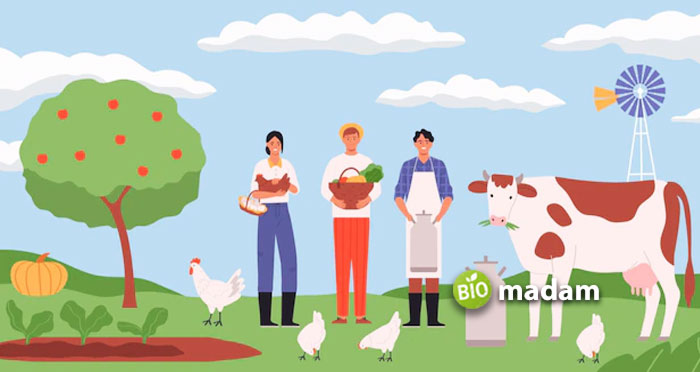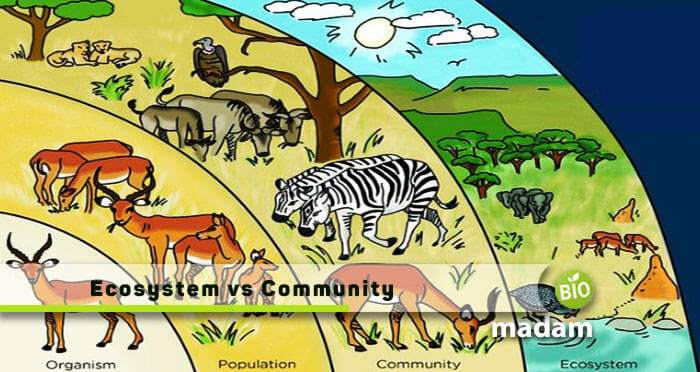Living in this world means being a subject of the biosphere, where the habitats, ecosystems and community are its principal parts. So, are you confused about finding the difference between ecosystem and community? We will briefly explain these two ecological stages to clear your conflicts at our best!
In simple words, the ecosystem links its features with the biotic environment that connects with abiotic factors. Whereas the community is an entire circle of living organisms residing at a particular place, in specific circumstances, and sharing some similar characteristics. There are several substantial dissimilarities between the two, but what’s the fundamental difference all?
The ecosystem talks about the relationship between both living organisms and non-living things. On the contrary, a community only interrelates the activities of living beings. Let’s step towards the comparison table between ecosystem and community. After that, we will discuss them in detail.
Comparison Chart
| Comparison | Ecosystem | Community |
| Components | Biotic & Abiotic | Biotic only. |
| Ecological Level | Larger | Smaller |
| Effect of Environment | Can alter an entire ecosystem | Influences a particular area of the community |
| Other Influencing Factors | Pollution, climate changes, habitat changes, etc. | Predation and climate change |
| Human Activities | Robot species, global warming, overgrazing | Removing marine lives, eliminating forests, etc. |
| Example | Terrestrial ecosystem | Group of different bird species in a forest |
Define Ecosystem
According to some ecologists, the ecosystem is defined as “the environment where we discuss all biotic and abiotic activities and interlinks them.” What do you understand by the term biotic and abiotic components? The biotic factors consist of minimal to healthy living beings. For example, from the smallest microorganisms to giant living organisms. Abiotic factors are everything from the sun, to the rivers, to the mountains, to oceans, to clouds, to rocks, and much more! All these falls under non-living things. An ecosystem can be terrestrial, aquatic, or marine, based on its type and size. Two common terminologies existing while describing ecosystems are, Resilience and Resistance!

Whenever there is fluctuation in the balance of an ecosystem, it refers to resilience. On the contrary side, resistance is a definite state of equilibrium in an ecosystem. We can classify an ecosystem into three chief components, including producers, consumers, and decomposers also called autotrophs, heterotrophs, and detritivores, respectively. Producers are autotrophs that struggle to prepare their own nutrition through photosynthesis in the presence of sunlight. Then comes the consumers, who are heterotrophs, relying on primary producers to fetch food and bring them up, for instance, human beings. Besides, decomposers are organism that resides on dead or decayed bodies. They convert fossils or other such materials to convert them in the soil to ingest. Examples include most fungi, molds, bacteria, and viruses.
Define Community
One can elaborate community as the communication between different living beings (biotic factors) within the same environment, holding standard features. Every living organism depends on others for its survival, so we are all connected in society, making a community. In other words, a community is a distinct subject of an ecosystem, consisting of several populations living altogether.
The structure of any community can be predicted through different living organisms residing in it. They can either survive by competing or predating each other. Two different birds can fight to win the nest where they live, making them fall under a community. Similarly, different animals prey on others to maintain a balance in all trophic levels and ultimately in the biomes and biosphere. Let’s quote an example of community.

There is a forest of trees where several animals live. Now different plant-eating animals will consume numerous types of green leaves, and those animals will be eaten by other animals to maintain equilibrium. Thus, no species will reside in excess, and a community will exist.
Differences Between Ecosystem and Community
Brief Description
Ecosystem
One can define an ecosystem as the permanence of significant life forms, which is the interrelationship of biotic and abiotic factors.
Community
All the living organisms linking to non-living things in a specific region, at a particular environment to drive equilibrium falls under community.
Role of Residing Organisms
Ecosystem
An ecosystem includes everything from living to non-living things.
Community
A community only includes interactions among biotic components.
Dependency of Abiotic Factors
Ecosystem
This ecological level includes every abiotic or non-living factor, such as oceans, sun, soil, different nutrients, etc.
Community
A community has nothing to do with abiotic factors and is independent of them.
Influenced By
Ecosystem
An ecosystem can face resilience through changes in organisms’ behavior. However, it will never alter with the changes in weather or climate, but transform into another.
Community
A community will only be influenced when one species from a genus attacks another for its survival, such as through the phenomenon of competition or predation.
Role of Human Activities
Ecosystem
Human activities can disturb or negatively impact an ecosystem by eliminating forests, introducing automation, etc.
Community
Some activities relating to killing wildlife or removing plants will highly affect a community.
Size of the Ecological Level

Ecosystem
It is comparatively larger because of more interactions of biotic and abiotic factors in an environment.
Community
It is comparatively petite because of limiting to only biotic factors of an environment.
Examples
Ecosystem
Different examples of an ecosystem include an aquatic ecosystem, marine ecosystem, terrestrial ecosystem, etc.
Community
Similarly, the community has hundreds and thousands of examples, such as various groups of people living in a country.
Bottom Line
We cannot deny either of these levels of the biosphere. After elaborating on the differences between ecosystem and community, their importance is all highlighted! Both of these terms are somehow interlinked and effects one another. An ecosystem balances the relation between living and non-living things, while a community is only responsible for handling biotic factors and their effects on the environment.

Hello, I would like to introduce myself to you! I am Chelsea Rogers, an experienced blog writer for science articles, holding an MPhil degree. My enthusiasm to grab the best knowledge, let it relate to botany, zoology, or any other science branch. Read my articles & let me wait for your words s in the comment section.


In an ecosystem, living organisms are classified into producers, consumers, and decomposers, the former representing all plant life, consumers eating the organisms that eat them and each other, and the latter representing those scavengers